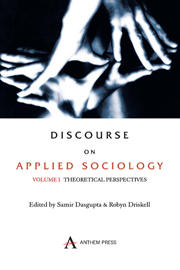Book contents
- Frontmatter
- Contents
- Preface and Acknowledgement
- Contributors to this Volume
- List of Abbreviations
- Introduction
- 1 Re-Orient World History, Social Theory and the Nineteenth Century
- 2 The Unique Complexity of Social Phenomena and the Uses of Social Science Knowledge
- 3 Unlimited Love, Compassion and Forgiveness: Acts of Moral Examplars
- 4 Theoretical Application
- 5 Applied Sociology's Need to Rethink the Tradition: Sociological Theorizing in a Global Framework
- 6 Social Analysis and Social Action
- 7 The Applied Sociologist as Craftsman
- 8 Applied Sociologists: Its Problems and Prospects
- 9 Sociology and its Application in Society: Giving Sociology its ‘Working’ Meaning
- 10 The Evolution of Sociology Back to its Applied Future
- 11 Contemporary Corporate Crime: Theoretical Perspectives, Cases & Consequences
- Index
7 - The Applied Sociologist as Craftsman
Published online by Cambridge University Press: 05 March 2012
- Frontmatter
- Contents
- Preface and Acknowledgement
- Contributors to this Volume
- List of Abbreviations
- Introduction
- 1 Re-Orient World History, Social Theory and the Nineteenth Century
- 2 The Unique Complexity of Social Phenomena and the Uses of Social Science Knowledge
- 3 Unlimited Love, Compassion and Forgiveness: Acts of Moral Examplars
- 4 Theoretical Application
- 5 Applied Sociology's Need to Rethink the Tradition: Sociological Theorizing in a Global Framework
- 6 Social Analysis and Social Action
- 7 The Applied Sociologist as Craftsman
- 8 Applied Sociologists: Its Problems and Prospects
- 9 Sociology and its Application in Society: Giving Sociology its ‘Working’ Meaning
- 10 The Evolution of Sociology Back to its Applied Future
- 11 Contemporary Corporate Crime: Theoretical Perspectives, Cases & Consequences
- Index
Summary
We propose that the applied sociologist is well described as a craftsman in much the sense that C Wright Mills had in mind in his famous description of the model social scientist in general in The Sociological Imagination (1959). Fair enough, most would say, go ahead and add that to the long list of what the applied sociologist is and isn't, should and should not be. But our claim is more presumptuous – we assert that the applied sociologist is probably nothing more than a particular and peculiar figure of craftsman. To evaluate this claim we must first understand what is meant and what is implied by this characterization. Once established, the craftsman heuristic may then provide a standard for identifying roles and activities for applied sociologists that are consistent and authentic.
The Craftsman as Pragmatist
We know that Mills made a study of the pragmatists in his Ph.D. dissertation and therefore, while The Sociological Imagination does not mention Pierce, James, or even Dewey by name, we suspect that Mills had in mind a pragmatist version of craftsmanship. However, we must explain what we mean by this and, in the spirit of the American School, why it matters. It is reassuring to point out that Horowitz, in his introduction to Mills' Sociology and Pragmatism (1964) documents a strong and ongoing influence of Mills' interest in Dewey in particular on his thought and writing throughout his career.
- Type
- Chapter
- Information
- Discourse on Applied SociologyTheoretical Perspectives, pp. 165 - 178Publisher: Anthem PressPrint publication year: 2007



